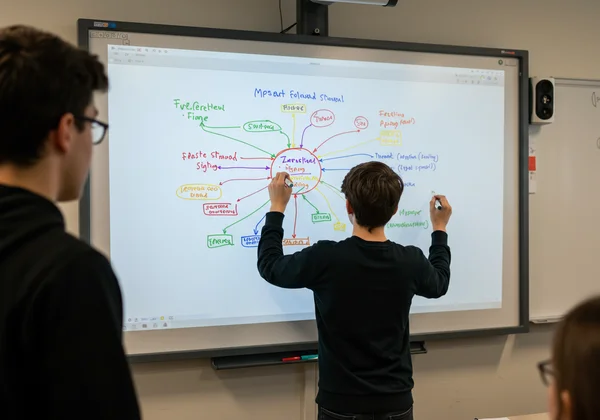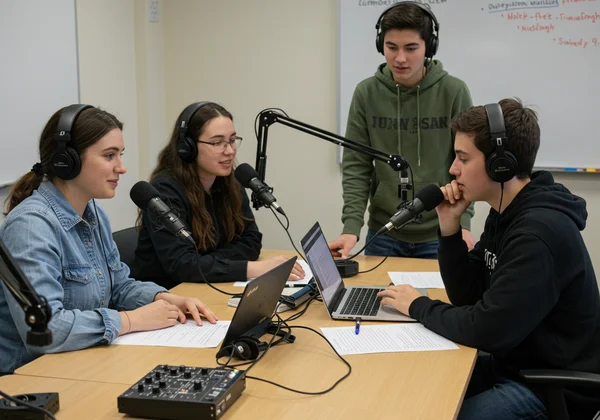VAK Learning Styles: 15 Practical Classroom Activities
As educators, we stand before a diverse tapestry of minds every day. Each student absorbs, processes, and retains information in a uniquely personal way. The challenge isn't just delivering the curriculum; it's making it resonate. This is where understanding VAK learning styles—Visual, Auditory, and Kinesthetic—becomes a superpower. By tailoring our teaching methods, we can unlock a new level of engagement and comprehension. But first, how do you identify your learning style?
The journey to a more dynamic classroom begins with insight. A great starting point is a learning style quiz, a simple tool that can provide a foundational understanding of student preferences. This guide will equip you with 15 practical activities to bring VAK principles to life, transforming your classroom into a space where every student has the opportunity to thrive. Ready to explore these strategies? You can always discover your learning style to better understand these concepts firsthand.

Understanding Visual Learners: Strategies & Activities
Visual learners thrive when they can see what they are learning. They absorb information best through images, diagrams, charts, and written text. These students often doodle in their notebooks, are skilled at reading maps, and prefer demonstrations over verbal instructions. They process the world through their eyes, making visual aids not just helpful, but essential for their success.
Identifying Your Visual Learners in Class
Look for students who are highly observant and often take detailed notes. They might color-code their assignments, use highlighters extensively, or be the first to notice a change on a bulletin board. When explaining a concept, they might say, "I see what you mean." These are strong indicators of a visual learning preference, a key insight for planning lessons.
Top Visual Teaching Activities for Enhanced Engagement

- Mind Mapping & Graphic Organizers: Instead of linear notes, encourage students to create mind maps with a central idea and branching concepts. Venn diagrams, flowcharts, and K-W-L charts are also excellent tools for organizing thoughts visually.
- Color-Coded Notes: Teach students to associate different colors with specific themes, vocabulary types, or levels of importance. This simple technique can transform a page of text into a structured, memorable guide.
- Educational Videos & Infographics: Supplement lessons with short, engaging videos, animated explanations, or visually rich infographics. Platforms like Khan Academy and YouTube are filled with content that can clarify complex topics.
- Interactive Whiteboard Sessions: Use the whiteboard or smartboard for more than just writing. Draw diagrams, have students come up to label parts of a picture, or create a collaborative visual brainstorm.
- Storyboarding: For literature, history, or even scientific processes, ask students to create a storyboard. This activity forces them to visualize the sequence of events, strengthening their comprehension and recall.
Engaging Auditory Learners: Discussion & Sound-Based Teaching
Auditory learners learn best by hearing. They excel with lectures, discussions, and listening activities. These students often have a strong command of language, enjoy reading aloud, and can remember spoken instructions with ease. They are the ones who might hum while they work or find silence distracting. For them, sound isn't noise; it's information.
How to Spot Auditory-Dominant Students
Auditory learners are often gifted conversationalists who enjoy group discussions and debates. They may read their work aloud to catch errors and can easily memorize song lyrics or poems. When asked a question, they might repeat it to themselves before answering. A simple free VAK test can help confirm these observational cues for both teachers and students.
Effective Auditory Classroom Activities

- Socratic Seminars & Debates: Pose an open-ended question and facilitate a structured discussion where students must listen carefully to their peers' arguments to build their own. Formal debates are also fantastic for honing listening and speaking skills.
- Podcast Creation: Have students work in groups to write, record, and produce a short podcast about a topic you're studying. This engages them in research, scripting, and verbal delivery, playing directly to their strengths.
- Read-Alouds & Peer Teaching: Regularly incorporate read-aloud sessions, either by you or by the students. Additionally, pair students up and have them teach a concept to their partner. Explaining something out loud solidifies understanding.
- Mnemonic Devices & Rhymes: Create catchy songs, jingles, or rhymes to help students remember facts, formulas, or vocabulary. The rhythm and melody make information stick in an auditory learner's brain.
- Guest Speakers & Audiobooks: Bring in experts to speak to the class or use excerpts from audiobooks to supplement reading assignments. Hearing a different voice or a professional narration can be highly engaging.
Empowering Kinesthetic Learners: Movement & Hands-On Experience
Kinesthetic learners, or tactile learners, learn by doing. They need to move, touch, and experience their lessons. Sitting still for long periods is their greatest challenge. These students excel in hands-on activities like science experiments, building projects, and role-playing. For them, learning is a full-body experience.
Recognizing Kinesthetic Learners in Your Classroom
These are your active students. They may tap their feet, fidget with objects, or ask for frequent breaks. They often volunteer for tasks that involve moving around the room and learn best through trial and error. To truly understand your students, look for those who prefer to build a model rather than write a report about it.
Dynamic Kinesthetic Classroom Activities

- Role-Playing & Skits: Instead of just reading a historical event or a scene from a play, have students act it out. This physical embodiment of the material creates powerful, lasting memories.
- Building & Manipulating Models: Use blocks, clay, or other materials to have students build models of cells, historical structures, or geometric shapes. The physical act of creation reinforces abstract concepts.
- Gallery Walks: Post questions, images, or problems around the classroom. Have students move from station to station, discussing and recording their ideas. This incorporates movement directly into the learning process.
- Hands-On Science Experiments: Whenever possible, move from theoretical science to practical application. Conducting experiments allows kinesthetic learners to see cause and effect in a tangible way.
- Classroom Stations: Set up different activity stations around the room, each focused on a different aspect of the lesson. Allow students to rotate through them, ensuring they are frequently moving and engaging with new tasks.
Beyond the Basics: Blending VAK for Diverse Classrooms
While understanding individual styles is crucial, the real magic happens when we create a learning environment that caters to everyone. Most students are a blend of all three styles, with one or two being more dominant. The goal isn't to label students but to provide multiple pathways to understanding. Great teaching incorporates elements from each VAK style into a single lesson.
Creating a Multifaceted Learning Environment
Think about a lesson on the water cycle. You could show a diagram and a video (Visual), lead a discussion and have students create a song about it (Auditory), and then have them build a terrarium to observe condensation and precipitation firsthand (Kinesthetic). This approach ensures that every student has a touchpoint that aligns with their preferred way of learning. It’s about creating a rich, multi-sensory experience.
Tips for Differentiated Instruction Success
Start small. You don't need to overhaul your entire curriculum overnight. Begin by adding one new VAK-focused activity to your weekly lesson plan. Offer choices for final projects: students can write a report (Visual), record a presentation (Auditory), or build a diorama (Kinesthetic). The key is flexibility and a willingness to meet students where they are. Tools like a learning styles quiz can provide the data you need to make these choices more effective.
Transform Your Classroom with VAK Insights
Integrating VAK learning styles into your teaching isn't about adding more work; it's about making your work more effective. By understanding and catering to the diverse ways students learn, you can boost engagement, reduce frustration, and foster a deeper love of learning. These 15 activities are just the beginning of a more inclusive and dynamic educational approach.
The first step is always awareness. Encourage your students, and even yourself, to discover their learning preferences. A simple, free learning style quiz can offer invaluable insights that empower both teaching and learning. Ready to unlock your students' full potential? Take the quiz today and start building a classroom where every learner can succeed.
Frequently Asked Questions About VAK Teaching
How do teachers effectively assess student learning styles?
While observation is a powerful tool, a more structured approach can provide clarity. A well-designed visual auditory kinesthetic test is an excellent starting point. These quizzes, like the free tool available on our site, offer a quick and accessible way for students to gain self-awareness. Combining these results with classroom observation and student feedback gives you a comprehensive picture.
Can a single activity engage all learning styles?
Absolutely. This is the goal of multi-sensory teaching. For example, a "gallery walk" involves students moving around the room (Kinesthetic), reading information and looking at images at each station (Visual), and discussing their findings with peers (Auditory). Designing activities with all three modalities in mind creates a rich learning environment that caters to everyone.
Is VAK the only learning style model I should consider?
The VAK model is one of the most straightforward and widely used frameworks, making it a great place to start. However, other models like VARK (which adds Reading/Writing as a fourth style) and Kolb's model of experiential learning also offer valuable insights. The key is not to adhere rigidly to one model but to embrace the principle of differentiated instruction.
What are the benefits of teaching to different learning styles?
When you teach to different learning styles, you increase student engagement, improve information retention, and reduce behavioral issues that often stem from boredom or frustration. It fosters a more inclusive classroom where students feel seen and understood, which builds confidence and promotes a positive attitude toward learning. Using a tool to find learning styles is a small investment with a huge potential return.